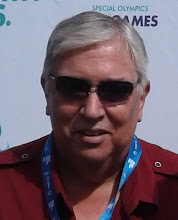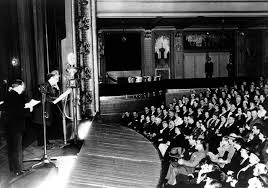Farewell, Amos: The Way It Was, 10 December
(NOTE: The following was published initially 10 November 2007; your chronicler learned subsequently that he was a month early in commemorating the event. Herewith a republication, under the proper date, with due apologies to his readers and to the family of the man now honoured for his incomparable contribution to old-time radio's art.---JK.)
1982: AU REVOIR---Freeman Gosden---who entertained millions, including several American presidents (at least one of whom, reputedly, refused interruption when the show was on the air), as one-half of old-time radio's ubiquitous (and, originally, groundbreaking) serial comedy-drama Amos 'n' Andy (as co-star and, with Charles Correll, co-writer)---dies of congestive heart failure, at age 83, in Los Angeles.
As a result of its extraordinary popularity, Amos 'n' Andy profoundly influenced the development of dramatic radio. Working alone in a small studio, Correll and Gosden created an intimate, understated acting style that differed sharply from the broad manner of stage actors---a technique requiring careful modulation of the voice, especially in the portrayal of multiple characters. The performers pioneered the technique of varying both the distance and the angle of their approach to the microphone to create the illusion of a group of characters. Listeners could easily imagine that that they were actually in the taxicab office, listening in on the conversation of close friends. The result was a uniquely absorbing experience for listeners who in radio's short history had never heard anything quite like Amos 'n' Andy.While minstrel-style wordplay humor was common in the formative years of the program, it was used less often as the series developed, giving way to a more sophisticated approach to characterization. Correll and Gosden were fascinated by human nature, and their approach to both comedy and drama drew from their observations of the traits and motivations that drive the actions of all people: while often overlapping popular stereotypes of African-Americans, there was at the same time a universality to their characters which transcended race.. . .The early 1930s saw criticism of the dialect and lower-class characterizations in the series by some African-Americans, but Amos 'n' Andy also had black supporters, who saw the series as a humanizing influence on the portrayal of blacks in the popular media. A campaign against the program by the Pittsburgh Courier in mid-1931 represented the most visible black opposition the radio series would receive---and while the paper claimed to have gathered hundreds of thousands of signatures against the series, the campaign was abruptly abandoned after six months of publicity failed to generate a clear consensus. Throughout Amos 'n' Andy's run, African-American opinion remained divided on the interpretation of the complex, often contradictory racial images portrayed in the program . . .. . . While audio recordings of most of the situation comedy episodes exist, most of the serial survives only as archival scripts, stored at the University of Southern California and the Library of Congress . Modern discussions of Amos 'n' Andy commonly focus more on deconstruction of its racial subtext than on factual examination of the original program---often obscuring the seminal role Freeman Gosden and Charles Correll played in the development of American broadcasting.---Elizabeth McLeod, from "Amos 'n' Andy In Person."I don't think blacks as a body resented the program. That certainly wasn't what we intended, nor did we ever feel it when we were on the air.---Freeman Gosden, in a rare interview in 1972.
Listen for yourself, think for yourself, but while you listen and think keep very much in mind that, often as not, Gosden and Correll also received---at the absolute height of the show's popularity (when it was still the cleverly-written and played fifteen-minute serial comedy-drama)---numerous invitations to perform live for black audiences . . . and no blackface.
Amos 'n' Andy, unlike many blackface acts [of the time], didn't drink, gamble, or cheat on their women---or eat pork chops, fried chicken, and watermelon. Gosden boasted that ministers and mothers praised the show's wholesomeness and "cleanliness." To quench any flickering protests, and for goodwill purposes, Gosden and Correll posed with black groups to promote their affection for and knowledge of urban blacks. A black newspaper, the Philadelphia Tribune, praised them as role models in their ability to re-create black culture; "Some of the imitators" of blacks, it noted, "are better than the original article." The leftist columnist Heywood Broun wrote that the pair went beyond racial or even comic considerations and could be enjoyed simply as "living, breathing persons." Many felt Amos 'n' Andy wasn't just funny but cathartic and universal and mirrored "life itself." One exuberant columnist called their humour "Shakespearean." A San Francisco reporter wrote that Gosden and Correll "never slur or make fun of the coloured race, and portray their characters in a human, appealing manner at all times" . . .. . . [T]hey inhabited an all-black community, but they weren't isolated from the country's real concerns, which the two comics were plunged into when the Depression struck only two months after Amos 'n' Andy went network. Indeed, Amos 'n' Andy reached its greatest popularity during---and due to---the Depression, when the characters' financial woes reflected the nation's but were funnier; they were worse off than most, but ever determined and optimistic . . .. . . Is there any radio or TV comedy today that could captivate a nation for more than three decades? Amos 'n' Andy was the show that did just that, more deserving of being cherished for its sly, charming self than for being chastised---in the safely enlightened sanctuary of hindsight---for what it was not.---Gerald Nachman, in "A Voice of Another Colour," from Raised on Radio. (New York: Pantheon Books, 1998.)
PEARL HARBOUR: THE AFTERMATH CONTINUES . . .
A nation and its radio begins to settle into the reality that the United States at last is at world war. Again.
THE THREE FRONT WAR---CBS News updates a passel of war maneuvers around the fulcrums of the battles.
"THREE DIRECT HITS"---That's what CBS News's John Daly, citing sources from the Army, reports were made by Army Air Corps bombers against Japanese ships in the Philippines. Also: Further war updates, including the situation in Hawaii itself three days after Pearl Harbour was attacked, and the British standing regarding its then-colony Hong Kong, among others.
CHANNEL SURFING . . .
1944: FROM SAN BERNARDINO, CALIFORNIA---Guest Dorothy Lamour joins the crew, barely recovered from Jack (Benny) and Don's (Wilson) argument over famous sayings, before a crowd of troops on tonight's edition of The Lucky Strike Program Starring Jack Benny. (NBC.)
Cast: Mary Livingstone, Phil Harris, Eddie Anderson, Larry Stevens. Announcer: Don Wilson. Music: Phil Harris Orchestra. Writers: George Balzar, Milt Josefsberg, Sam Perrin.
1950: "AND WHAT PATENT MEDICINE ARE YOU SELLING?"---Clifton Webb opens with some good-natured needling of hostess Tallulah Bankhead's newfound radio and lecturing life, before the typical striking potpourri of comedy, music, and drama, on tonight's edition of The Big Show. (NBC.)
Additional guests: Eddy Arnold, Charles Boyer, Joe Bushkin, Mindy Carson, Imogene Coca, Jimmy Durante. Music: Meredith Willson Orchestra, the Big Show Chorus. Writers: Goodman Ace, Selma Diamond, Frank Foster, Mort Greene.
1952: THE SECRET WORD IS "FIRE"---A special treat to open the show: Groucho Marx sings two verses from his longtime theme, "Hooray for Captain Spaulding." Then, a French war bride (World War I, in fact) and a film grip; a processed food packer and a theater manager; and, a UCLA teaching student and a small business owner get to bathe in Groucho's usual repartee, on tonight's edition of You Bet Your Life. (NBC.)
Announcer: George Fenneman.
PREMIERING TODAY . . .
1889---Ray Collins (actor: County Seat; Mercury Theater of the Air; Suspense), Sacramento, California; Arthur Vinton (actor: Buck Rogers; The Shadow), Brooklyn.
1903---Una Merkel (actress: The Great Gildersleeve; Johnny Presents; Texaco Star Theater), Covington, Kentucky.
1911---Chet Huntley (Chester Robert Huntley; newscaster/commentator: They Burned the Books), Cardwell, Colorado.
1913---Morton Gould (conductor: Music for Today; The Original Amateur Hour; The Cresta Blanca Carnival), Richmond Hill, New York.
1914---Jean Dickenson (The Nightengale of the Airwaves; soprano: American Album of Familiar Music; Hollywood Hotel), Montreal; Dorothy Lamour (as Mary Leta Dorothy Slaton; actress: The Chase & Sanborn Hour; Front and Center; The Bob Hope Show; The Lucky Strike Program Starring Jack Benny; The Sealtest Variety Show), New Orleans.
1920---Dennis Morgan (singer/actor: Lux Radio Theater; U.S. Steel Hour; Screen Guild Theater), Prentice, Wisconsin.
1903---Una Merkel (actress: The Great Gildersleeve; Johnny Presents; Texaco Star Theater), Covington, Kentucky.
1911---Chet Huntley (Chester Robert Huntley; newscaster/commentator: They Burned the Books), Cardwell, Colorado.
1913---Morton Gould (conductor: Music for Today; The Original Amateur Hour; The Cresta Blanca Carnival), Richmond Hill, New York.
1914---Jean Dickenson (The Nightengale of the Airwaves; soprano: American Album of Familiar Music; Hollywood Hotel), Montreal; Dorothy Lamour (as Mary Leta Dorothy Slaton; actress: The Chase & Sanborn Hour; Front and Center; The Bob Hope Show; The Lucky Strike Program Starring Jack Benny; The Sealtest Variety Show), New Orleans.
1920---Dennis Morgan (singer/actor: Lux Radio Theater; U.S. Steel Hour; Screen Guild Theater), Prentice, Wisconsin.












4 Comments:
Sounds to me like Freeman was way ahead of his time man. Great story.
In many ways, Freeman Gosden and Charles Correll were ahead of their time. If one troubles to listen to the original show (the original serial comedy, not the bowdlerised half-hour sitcom of later years, that is), and not the mythologies it inspired, you can make a case that Gosden and Correll performed a large role in humanising blacks and their experience of the time and place in the ears and mind's eyes of millions of Americans, regardless of the point that Gosden and Correll were white men. (McLeod and others remind us that many black listeners---and audiences, who invited the pair to perform for them live, even sans makeup---listened to the show in precisely that way, whatever they thought or hoped in terms of honest-to-goodness black performers maybe catching a break in due course.)
That so many got their first hint of black humanness from Amos 'n' Andy's wry comedy is itself, considering its time and place, no small accomplishment.
---Jeff
It is a shame there are not more Amos and Andy radio shows available for listening. Considering the show started in the 20's and ended in the 50's the 300 or so shows still existing are only a fraction of the shows made. Only about 8 years of shows are still with us while the other 20 or so years are lost forever unless they are in storage.
Andrew---You never know what might turn up when or where. To name one of the most recent examples of surprise finds, there are all those recordings of the fifteen-minute, semi-serial version of Fibber McGee & Molly from 1953 forward that have shown up in the last year or so. And they're just as funny---sometimes more so, and the absence of the audience actually lets you absorb the jokes your way---in that form as they were in their half-hour, semi-variety heyday.
Perhaps somewhere there might be an unexhumed repository of the 1929-39 Amos 'n' Andy vintage, not to mention The Goldbergs. You never know.
---Jeff
Post a Comment
Subscribe to Post Comments [Atom]
<< Home